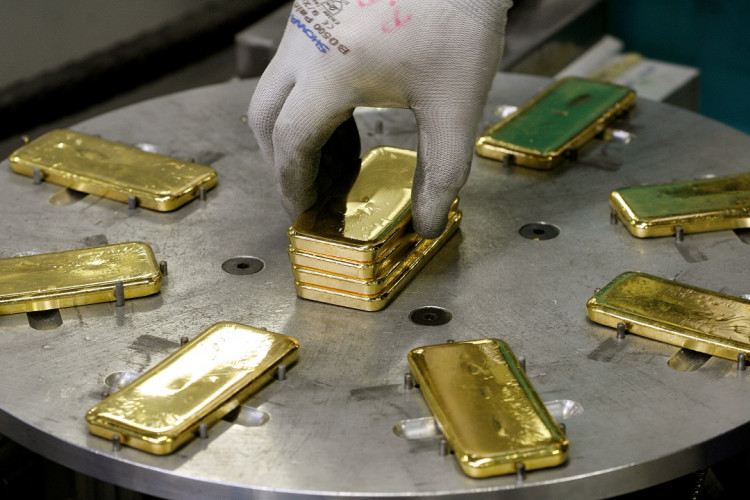Gold prices took a hit on Monday, falling more than 1% as a surge in equities and profit-taking by investors contributed to the decline. This drop comes after a sharp rally in the previous session fueled by expectations that the U.S. Federal Reserve might cut interest rates as early as September.
Spot gold was down 1.4% to $2,357.88 per ounce by mid-afternoon, after peaking at its highest level since May 22 on Friday. U.S. gold futures settled 1.4% lower at $2,363.50.
"This looks like a lot of profit-taking, and the equities are strong this morning here, which kind of has a little bit of a competing factor with precious metals," said Bob Haberkorn, senior market strategist at RJO Futures. The Nasdaq and the S&P 500 hit record highs, while the Dow Jones Industrial Average scaled a one-month high.
Despite the current dip, Haberkorn remained optimistic about gold's future. "I believe you'll see gold higher based off the prediction that the Fed is going to be cutting rates. The Fed watch tool saw rate cuts coming in September and then another cut possibly in November and December that will be bullish for gold."
Data from last week indicated a slowing labor market, which keeps the U.S. central bank on course to begin cutting interest rates soon. Markets are currently pricing in a 71% chance of a rate cut in September, with another cut expected in December. Kyle Rodda, a financial market analyst at Capital.com, noted, "If we get another downside surprise in inflation data, which we have seen pretty consistently in U.S. data, then that's going to be a tailwind for gold."
Investors will be keenly focused on Fed Chair Jerome Powell's semi-annual Congressional testimony, comments from various Fed officials, and the U.S. inflation data due on Thursday.
Gold Weakens as Treasury Yields Rise Amid Political Uncertainty
Gold's decline on Monday also aligns with a broader trend of falling commodities, driven by global growth concerns following subpar U.S. employment data last week. Rising U.S. Treasury bond yields, spurred by increased probabilities of a potential return of former President Donald Trump to office, have further pressured gold prices. Trump's anticipated fiscal policies, which include tax cuts and maintained spending, are expected to drive higher inflation and interest rates-conditions typically unfavorable for non-interest-bearing assets like gold.
Gold traded in the $2,370s on Monday, down from Friday's peak of $2,393. Despite weaker labor market data boosting bets on earlier-than-expected Fed rate cuts, gold prices have been influenced by the so-called "Trump-put" on bond markets. The specter of higher inflation and interest rates under a potential Trump administration has impacted U.S. Treasury bonds, pushing up yields and consequently weighing on gold prices.
Geopolitical Tensions and Central Bank Demand Provide Support for Gold
While gold faces pressure from rising bond yields and a strengthening U.S. dollar, it continues to find support from geopolitical tensions and central bank demand. The ongoing conflicts in the Middle East and Ukraine have driven nervous investors to store their wealth in gold. Additionally, the BRICS intergovernmental organization's efforts to de-dollarize global trade have bolstered gold's long-term outlook, positioning it as a viable alternative to the U.S. dollar.
Central bank demand, which accounts for roughly a quarter of the gold market, remains strong. After the U.S. dollar's unexpected strength in the first quarter of 2024, Asian central banks have accumulated gold to hedge against their domestic currencies' depreciation against the dollar.
Technical Analysis: Gold's Path Forward
Technically, gold has reached a major resistance level at the June 7 high of $2,388. If it can break above Friday's peak of $2,393, it could continue the sequence of higher highs, potentially targeting the $2,451 all-time high. The recent recovery has invalidated the bearish Head & Shoulders topping pattern that formed from April to June, although there remains a possibility of a more complex topping pattern. Should the price break below the pattern's neckline at $2,279, a conservative target of $2,171 might be anticipated.
In the short and medium term, gold's trend appears sideways, while the long-term trend remains upward. The interplay of these technical factors with macroeconomic and geopolitical developments will be crucial in determining gold's trajectory in the coming months.






